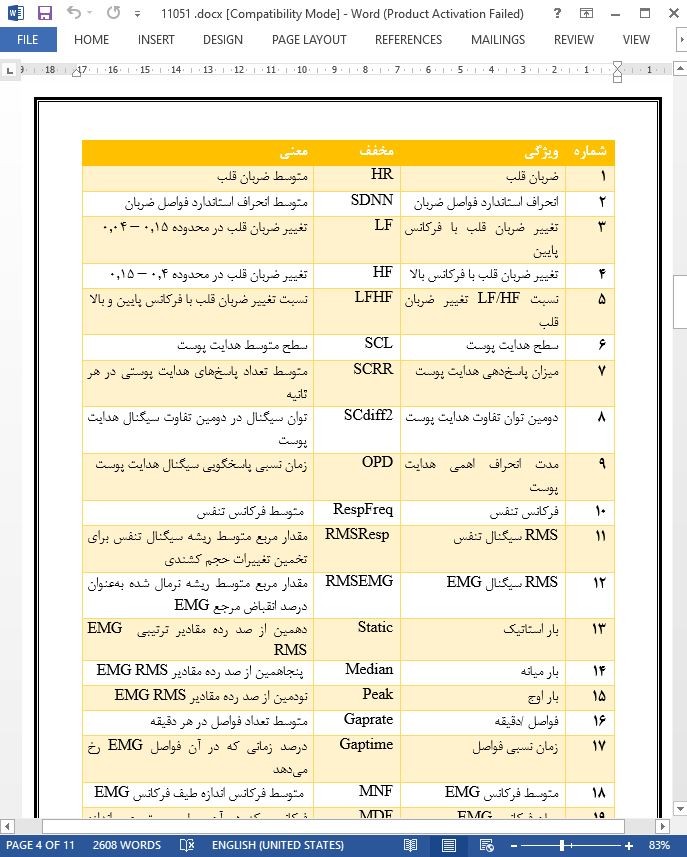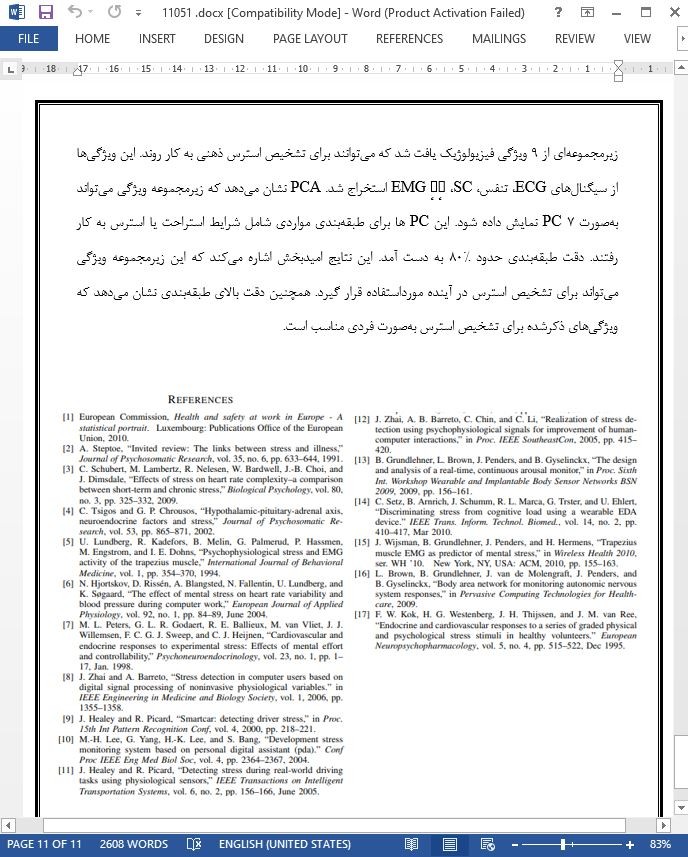
تشخیص استرس ذهنی با استفاده از حسگرهای فیزیولوژیک پوشیدنی
چکیده
تشخیص زودهنگام استرس ذهنی میتواند از بسیاری از مشکلات سلامتی مرتبط با استرس جلوگیری کند. هدف پژوهش حاضر بهکارگیری یک سامانه حسگر پوشیدنی برای سنجش سیگنالهای فیزیولوژیکی و تشخیص استرس ذهنی است. یک گروه از افراد سالم در معرض سه موقعیت استرسزای متفاوت قرار گرفتند. در مدت این عمل، ECG، تنفس، میزان رسانایی پوست و EMG عضلات تراپزیوس ثبت شد. در کل 19 ویژگی فیزیولوژیکی از این سیگنالها محاسبه شد. پس از نرمالسازی مقادیر هر ویژگی و تحلیل همبستگی آنها، زیرمجموعهای از 9 ویژگی برای تحلیل بیشتر انتخاب شد. تحلیل جزء اصلی، این 9 ویژگی را به 7 جزء اصلی کاهش میدهد (PC ها). با استفاده از این PC ها و طبقهبندی کنندههای متفاوت، دقت طبقهبندی ثابتی بین شرایط استرس و غیر استرس در حدود 80% به دست آمد. این نشاندهنده آن است که زیرمجموعه ویژگی خوبی برای توسعه نظارت شخصی بر استرس در آینده بهدستآمده است.
1. مقدمه
دومین مشکل سلامتی مرتبط باکار ازنظر فراوانی در جامعه اروپا «استرس، افسردگی یا اضطراب» است [1]. 25% از غیبت یکماهه یا بیشتر، به خاطر بیماریهای ناشی از استرس، افسردگی یا اضطراب است. این ارقام نشاندهنده آن است که استرس در جامعه اروپا یک مشکل مهم مالی و اجتماعی است.
استرس ذهنی مزمن، میتواند سبب مشکلاتی مانند فشارخون [2]، بیماریهای قلبی عروقی [3]، افزایش احتمال عفونت [2] و افسردگی [4] شود. استرس ذهنی را در مراحل اولیه میتوان تشخیص داد و از مشکلات سلامتی مرتبط با استرس جلوگیری کرد.
5. نتیجهگیری
زیرمجموعهای از 9 ویژگی فیزیولوژیک یافت شد که میتوانند برای تشخیص استرس ذهنی به کار روند. این ویژگیها از سیگنالهای ECG، تنفس، SC، ٍٍ EMG استخراج شد. PCA نشان میدهد که زیرمجموعه ویژگی میتواند بهصورت 7 PC نمایش داده شود. این PC ها برای طبقهبندی مواردی شامل شرایط استراحت یا استرس به کار رفتند. دقت طبقهبندی حدود 80% به دست آمد. این نتایج امیدبخش اشاره میکند که این زیرمجموعه ویژگی میتواند برای تشخیص استرس در آینده مورداستفاده قرار گیرد. همچنین دقت بالای طبقهبندی نشان میدهد که ویژگیهای ذکرشده برای تشخیص استرس بهصورت فردی مناسب است.
Abstract
Early mental stress detection can prevent many stress related health problems. This study aimed at using a wearable sensor system to measure physiological signals and detect mental stress. Three different stress conditions were presented to a healthy subject group. During the procedure, ECG, respiration, skin conductance, and EMG of the trapezius muscles were recorded. In total, 19 physiological features were calculated from these signals. After normalization of the feature values and analysis of correlations among these features, a subset of 9 features was selected for further analysis. Principal component analysis reduced these 9 features to 7 principal components (PCs). Using these PCs and different classifiers, a consistent classification accuracy between stress and non stress conditions of almost 80% was found. This suggests that a promising feature subset was found for future development of a personalized stress monitor.
I. INTRODUCTION
The second most frequently occurring type of workrelated health problems in the European population is ‘stress, depression or anxiety’ [1]. Of the sickness absence for one month or more, 25% was caused by stress, depression or anxiety. These figures indicate that stress is a major financial and social problem in European society. Chronic mental stress can cause health problems which include for example hypertension [2], cardiovascular diseases [3], increased likelihood of infections [2] and depression [4]. If mental stress could be detected in an early stage, stress relatedhealth problems couldbe prevented.
V. CONCLUSIONS
A subset of 9 physiological features was found that can be used for mental stress detection. The features were extracted from ECG, respiration, SC, and EMG signals. PCA indicated that the feature subset could be expressed as 7 PCs. These PCs were used for classification of cases into rest or stress conditions. A classification accuracy of almost 80% was found. This promising result indicates that this feature subset can be used for stress detection in the future. The high classification accuracy also indicates that the features are suitable for individual stress detection.
چکیده
1. مقدمه
2. روشها
الف- پروتکل آزمایشی
ب- ثبت فیزیولوژیک
پ - محاسبه ویژگی
ت - شیوههای تحلیل
3. نتایج
4. بحث
5. نتیجهگیری
Abstract
I. INTRODUCTION
II. METHODS
A. Experimental protocol
B. Physiological recordings
C. Feature calculation
D. Analysis methods
III. RESULTS
IV. DISCUSSION
V. CONCLUSIONS
- اصل مقاله انگلیسی با فرمت ورد (word) با قابلیت ویرایش
- ترجمه فارسی مقاله با فرمت ورد (word) با قابلیت ویرایش، بدون آرم سایت ای ترجمه
- ترجمه فارسی مقاله با فرمت pdf، بدون آرم سایت ای ترجمه



